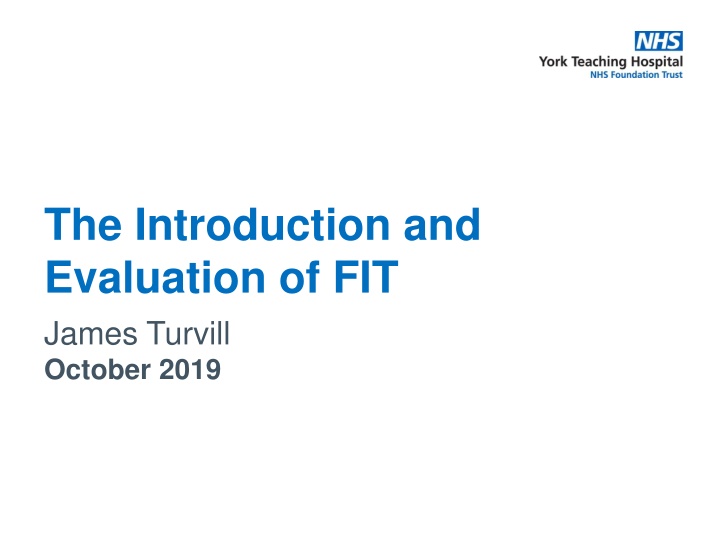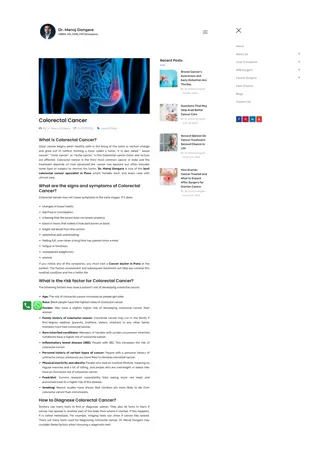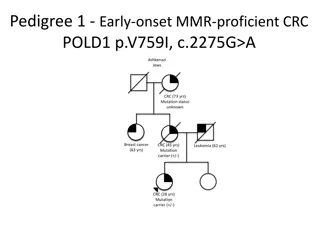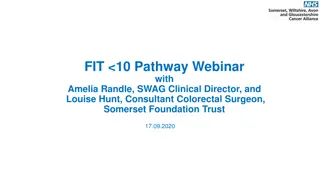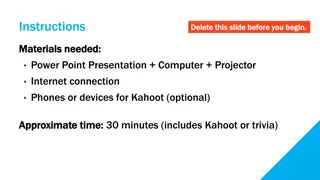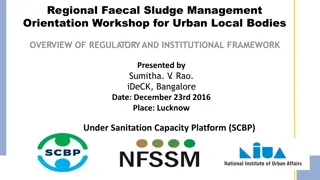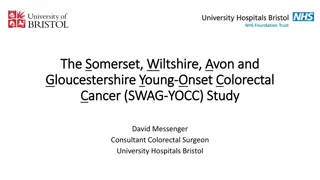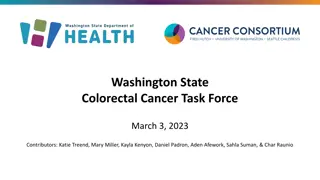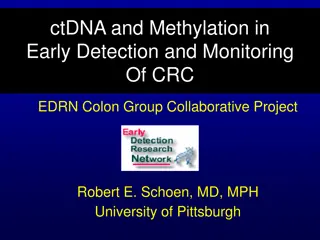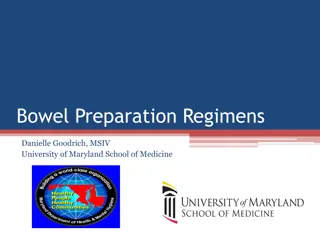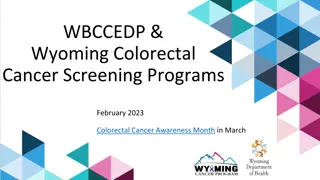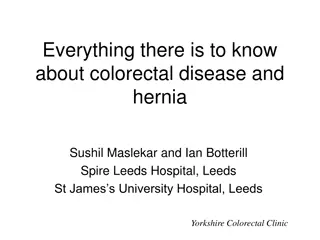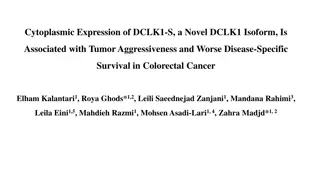Overview of Faecal Immunochemical Test (FIT) and Faecal Calprotectin in Colorectal Screening
Introduction and evaluation of Faecal Immunochemical Test (FIT) and Faecal Calprotectin for colorectal cancer screening, focusing on the indications for use, exclusion criteria, economic evaluation, and comparison with standard care. Information includes age-specific screening recommendations, differential diagnostic considerations, and outcomes of implementing these tests.
Download Presentation

Please find below an Image/Link to download the presentation.
The content on the website is provided AS IS for your information and personal use only. It may not be sold, licensed, or shared on other websites without obtaining consent from the author.If you encounter any issues during the download, it is possible that the publisher has removed the file from their server.
You are allowed to download the files provided on this website for personal or commercial use, subject to the condition that they are used lawfully. All files are the property of their respective owners.
The content on the website is provided AS IS for your information and personal use only. It may not be sold, licensed, or shared on other websites without obtaining consent from the author.
E N D
Presentation Transcript
The Introduction and Evaluation of FIT James Turvill October 2019
Faecal Immunochemical Test for haemoglobin FIT BCSP Asymptomatic screening 60-74years Cut-off 120 g Hb/g faeces 2ww patients for suspected colorectal cancer Research Patients at low risk for colorectal cancer NICE DG30
Faecal Immunochemical Test for haemoglobin FIT BCSP Asymptomatic screening 60-74years Cut-off 120 g Hb/g faeces 2ww patients for suspected colorectal cancer Research Patients at low risk for colorectal cancer NICE DG30
Indications for use of FIT in DG30 People: without rectal bleeding who have unexplained symptoms that do not meet the criteria for a suspected cancer pathway REPLACES People: >50yrs with unexplained abdominal pain weight loss <60yrs with changes in their bowel habit iron-deficiency anaemia >60yrs with anaemia even in the absence of iron deficiency
Faecal Calprotectin IBS v IBD use in adults new lower gastrointestinal symptoms cancer is not suspected NICE DG11
Exclusion criteria: Cancer suspected (NICE guideline NG12. https://www.nice.org.uk/guida nce/ng12) Inclusion criteria: Adult 18-60 years New lower gastrointestinal symptoms Norma or negative initial workup (FBC,U&E,Cr,TFT,CRP,Ca, coeliac screen) Stool culture / C. difficile screen as appropriate
YFCCP economic evaluation Health economic evaluation with YHEC Outcome data compared against historic standard care, predicted outcomes from FC usage and outcomes from this implementation using standard cut off (per 1000 pts) York Health Economics Consortium Intervention No FC (ESR + CRP) Incremental Total costs Correctly diagnosed IBS cases Correctly diagnosed IBD cases Unnecessary colonoscopies (i.e. false +ves) 308,954 849 66 79 416,839 677 25 251 - 107,885 172 41 -172 Intervention Standard cut-off Incremental Total costs Correctly diagnosed IBS cases Correctly diagnosed IBD cases Unnecessary colonoscopies (i.e. false +ves) 308,954 849 66 79 467,820 562 68 366 - 158,866 287 -1 -287
FIT NICE DG30: FIT for low risk patients How does it fit with FC?
FIT NICE DG30: FIT for low risk patients
FIT NICE DG30: FIT for low risk patients ?
Roll out of FIT: the challenges Introduce FIT Evaluate FIT Compare the effectiveness of FC and FIT 18-59 years 60 years FC v FIT YFCCP + FIT not high risk for CRC (2ww) abdominal pain not high risk for CRC (2ww) baseline investigations normal diagnostic uncertainty not isolated rectal bleeding FC and FIT weight loss anaemia in the absence of iron deficiency FIT
Diagnostic accuracy study: 1 Patient presents with possible lower gastrointestinal disease Baseline assessment and investigations as appropriate FBC, CRP, ferritin, TFT, coeliac screen Stool culture, C.difficile toxin Not 2ww for cancer Diagnostic uncertainty Not isolated rectal bleeding: surgical referral
Patient 18-59yrs Only Calprotectin available to request Question to prompt GP to request FC for: 1) Diagnostic care pathway: IBS v IBD 2) IBD monitoring If you tick IBS v IBD FIT auto requested This Help prompt appears to help: universal pot and FIT pack If IBD monitoring : you just get the FC
YFCCP requests and referrals
YFCCP prevalence of disease Prevalence of organic colonic disease: IBD, significant polyps and colorectal cancer by age and referral/endoscopic pathway.
Suspecting cancer.. how to interpret 1.3.3 consider a suspected cancer pathway referral for colorectal cancer in adults < 50y with rectal bleeding & unexplained: abdominal pain change in bowel habit weight loss iron-deficiency anaemia
Patient 60yrs Both tests available to request if needed Choose an option in order to proceed. FIT test selected - this pop-up box appears One of the top three options selected: This pop-up box then appears Calprotectin cannot be co-requested with FIT
Diagnostic accuracy study: 2 18-59 years: option to request FC ICE will ask then you to request FIT 60 years: option to request FIT Specific indications for referral Patient pack Information sheet Patient questionnaire Consent form FIT picker Instructions for use SAE Universal container (blue top) Conventional (safety netted) follow up with results
FIT needs a picker What the patient needs to do: Name Date of birth Date of sampling
Diagnostic accuracy study: 3 60 years: FIT positive: 2ww colorectal referral FIT negative: reassure colorectal cancer very unlikely treat symptomatically and review routine referral or consider uro-gynaecological disease 18-59 years: follow the YFCCP FC <100: IBS likely FC 100: repeat repeat FC <100: IBS likely repeat FC 100-250: routine gastroenterology referral repeat FC >250: STT colonoscopy/urgent gastroenterology referral IF FC <250 ON COMPLETION OF YFCCP BUT ANY FIT IS POSITIVE: 2WW COLORECTAL REFERRAL
Exclusion criteria: Cancer suspected (NICE guideline NG12. https://www.nice.org.uk/gui dance/ng12) Inclusion criteria: Adult 18-60 years New lower gastrointestinal symptoms Norma or negative initial workup (FBC,U&E,Cr,TFT,CRP,Ca , coeliac screen) Stool culture / C. difficile screen as appropriate
FIT+ve: 2WW Exclusion criteria: Cancer suspected (NICE guideline NG12. https://www.nice.org.uk/gui dance/ng12) Inclusion criteria: Adult 18-60 years New lower gastrointestinal symptoms Norma or negative initial workup (FBC,U&E,Cr,TFT,CRP,Ca , coeliac screen) Stool culture / C. difficile screen as appropriate
FIT+ve: 2WW FIT+ve: 2WW Exclusion criteria: Cancer suspected (NICE guideline NG12. https://www.nice.org.uk/gui dance/ng12) Inclusion criteria: Adult 18-60 years New lower gastrointestinal symptoms Norma or negative initial workup (FBC,U&E,Cr,TFT,CRP,Ca , coeliac screen) Stool culture / C. difficile screen as appropriate
FIT+ve: 2WW FIT+ve: 2WW Exclusion criteria: Cancer suspected (NICE guideline NG12. https://www.nice.org.uk/gui dance/ng12) FIT+ve: 2WW Inclusion criteria: Adult 18-60 years New lower gastrointestinal symptoms Norma or negative initial workup (FBC,U&E,Cr,TFT,CRP,Ca , coeliac screen) Stool culture / C. difficile screen as appropriate
Diagnostic accuracy study: 4 GP management/referral guidance will be provided by the laboratory to accompany the FC/FIT result GP information sheet Training video FIT positive indication for referral will be added to the 2ww for suspected colorectal proforma Safety netting Data collection
Expected outcomes 60 years: numbers? FIT positive: 10% significant disease: 50% 18-59 years: numbers? current YFCCP requests: 4000/year FC requests as a proportion of referrals: 15% FC positive: 15% FC>250 significant disease: 50% FIT positive and FC negative: 5% significant disease: 60% numbers needed to diagnose significant disease YFCCP: No YFCCP: 6.8 FC/FIT negative: follow the YFCCP reassure, treat and review 3.8
Thank you Any queries, contact me: James.Turvill@York.NHS.UK 01904 725480
